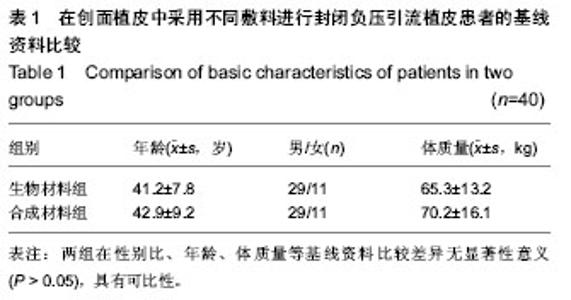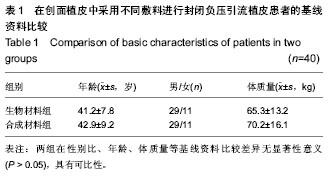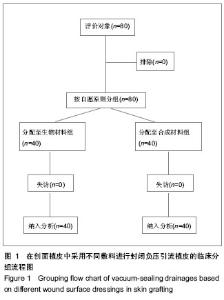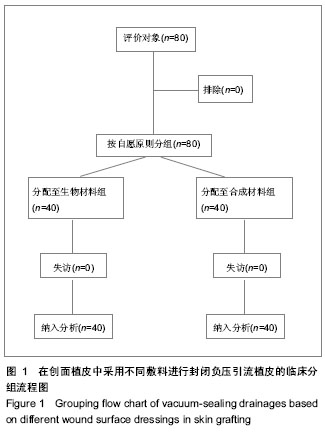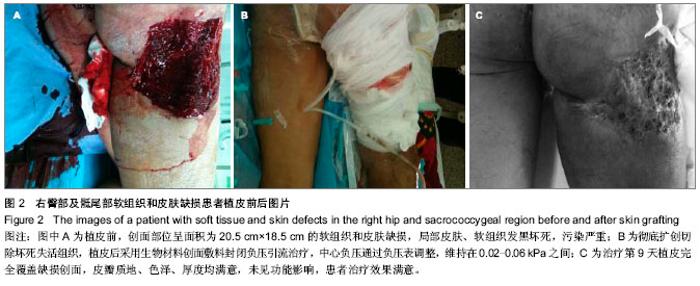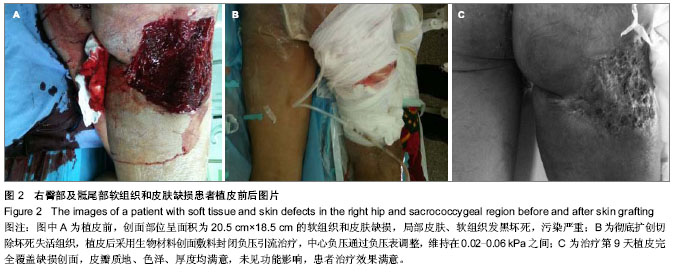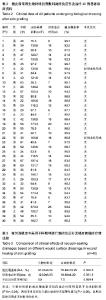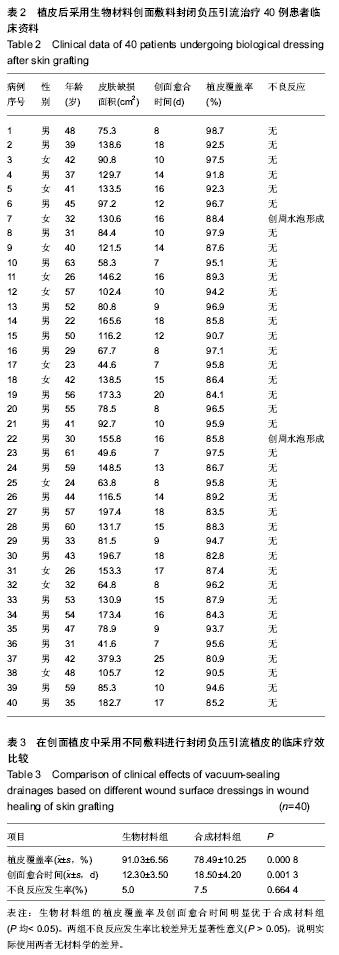| [1] Fleischmann W,Strecker W,Bombelli M,et al.Vacuum sealing as treatment of soft tissue damaye in open fracture. Unfallchiurg. 1993;96(9):488-492.[2] Li RG,Ren GH,Tan XJ,et al.Free flap transplantation combined with skin grafting and vacuum sealing drainage for repair of circumferential or sub-circumferential soft-tissue wounds of the lower leg.Med Sci Monit.2013;28(19):510-517.[3] Qu J,Yan R,Wang L,et al.Free dermatoplasty combined with vacuum sealing drainage for the treatment of large-area soft tissue defects accompanied by bone exposure in the lower leg.Exp Ther Med.2013;5(5):1375-1380. [4] 岑石强,黄富国,杨天府,等.封闭式负压引流技术在“5.12”汶川大地震伤员创面中的早期应用疗效[J].中国修复重建外科杂志, 2009,23(6):657-659.[5] Liao Q,Xu J,Weng XJ,et al.Effectiveness of vacuum sealing drainage combined with anti-taken skin graft for primary closing of open amputation wound. Zhongguo Xiu Fu Chong Jian Wai Ke Za Zhi.2012;26(5):558-562.[6] Niu Z,Deng Y,Sun Y,et al.Application of vacuum sealing drainage in severe skin closed internal degloving injury. Zhongguo Xiu Fu Chong Jian Wai Ke Za Zhi. 2012;26(1): 61-63.[7] 李永忠,胡晓东,Topaz M,等.简易封闭式负压引流治疗35例汶川地震伤员创面的效果分析[J].中国循证医学杂志,2009,9(3): 279-282.[8] Lun XG,Zhang XH,Li XM.Vacuum sealing drainage (VSD) for the treatment of large cutaneous deficiency of inferior belly and left thigh: a case report. Zhongguo Gu Shang.2011; 24(11): 947-948.[9] Malmsjö M,Ingemansson R,Lindstedt S,et al.Comparison of bacteria and fungus-binding mesh, foam and gauze as fillers in negative pressure wound therapy - pressure transduction, wound edge contraction, microvascular blood flow and fluid retention.Int Wound J.2013;10(5):597-605. [10] Cigna E,Maruccia M,Sorvillo V,et al.The use of negative pressure therapy and hyaluronic acid for the management of post-traumatic lower limb injury.Int Wound J. 2013;10(5): 534-538. [11] Ito H,Arao M,Ishigaki H,et al.The use of negative pressure wound therapy to treat wound necrosis and groin lymphorrhea after inguinal lymph nodes dissection: a case report.Nihon Hinyokika Gakkai Zasshi.2012;103(1):22-26.[12] Fang LM,Zhang YJ,Zheng JY,et al.Early treatment of large soft-tissue wounds with intermittent vacuum sealing drainage.Zhonghua Yi Xue Za Zhi. 2011;91(33):2329-2332.[13] Zhang WK,Wang HB,Mao GL,et al.Vacuum sealing drainage and free coupling chain-link posterior tibial artery flap in the reconstruction of degloving injury of propodium.Zhonghua Zheng Xing Wai Ke Za Zhi.2013;29(4):258-260.[14] 邹晓防,蒋玉洁,曹卫红,等.可冲洗负压封闭引流技术在复杂性创面修复中的应用[J].创伤外科杂志,2011,13(1):76.[15] Camps I,Armtar F,Cuadrado M,et al.VAC(vacuum-assisted closure)“covered”laparostomy to control abdominal cmpartmental syndrome in a case of emphysematous pancreatitis.Cir Esa.2009;86(4):250-251.[16] Lable L,Rancan M,Mica L,et al.Vacuum-assisted closure therapy increases local interleukin-8 and vascular endothelial growth factor levels in traumatic wounds.J Trauma.2009; 66(3):749-757.[17] Liu L,Tan G,Luan F,et al.The use of external fixation combined with vacuum sealing drainage to treat open comminuted fractures of tibia in the Wenchuan earthquake.Int Orthop. 2012; 36(7):1441-1447.[18] Tang J,Guo WC,Yu L,et al.Clinical efficacy of artificial skin combined with vacuum sealing drainage in treating large-area skin defects.Chin J Traumatol.2010;13(5):289-292.[19] 中华人民共和国国务院.医疗机构管理条例.1994-09-01.[20] 徐海栋,赵建宁,卢俊浩,等.创面敷料封闭负压引流治疗慢性创面[J].中国组织工程研究,2013,17(16):3026-3032.[21] 徐海栋,赵建宁,赏后来,等.生物材料创面敷料封闭负压引流在大面积创面植皮中的应用[J].中国组织工程研究,2012,16(3): 543-546.[22] Apelqvist J,Armstrong DG,Lavery LA,et al.Resource utilization and economic costs of care based on a randomized trial of vacuum-assisted closure therapy in the treatment of diabetic foot wounds.Am J Surg.2008;195(6):782-788.[23] Moran SG,Windham ST,Cross JM,et al.Vacuum-assisted complex wound closure with elastic vessel loop augmentation: a novel technique.J Wound Care.2003; 12(6):212-213.[24] 薛云,刘兴炎,葛宝丰,等.封闭负压引流对软组织爆炸创面的影响[J].中国矫形外科杂志,2011,19(6):495-498.[25] 熊发明,刘兴炎,葛宝丰,等.封闭负压引流对早期处理爆炸创面的细菌和微循环的影响[J].中国矫形外科杂志,2010,18(2): 147-150.[26] 刘洋,胡大海,董茂龙,等.负压封闭引流治疗小鼠创面铜绿假单胞菌感染的效果及机制[J].中华烧伤杂志,2011,27(4):255-259.[27] Mouës CM,Heule F,Hovius SE.A review of topical negative pressure therapy in wound healing: sufficient evidence? Am J Surg.2011;201(4):544-556.[28] 蒋琪霞,刘玉秀,印洪林,等.负压伤口治疗中2种填充敷料对伤口血管化和组织增殖活性的研究[J].医学研究生学报,2012,25(2): 175-179.[29] Malmsjö M,Lindstedt S,Ingemansson R.Influence on pressure transduction when using different drainage techniques and wound fillers (foam and gauze) for negative pressure wound therapy.Int Wound J.2010;7(5):406-412. [30] Derrick KL,Norbury K,Kieswetter K,et al.Comparative analysis of global gene expression profiles between diabetic rat wounds treated with vacuum-assisted closure therapy, moist wound healing or gauze under suction.Int Wound J.2008;5(5): 615-624. |
